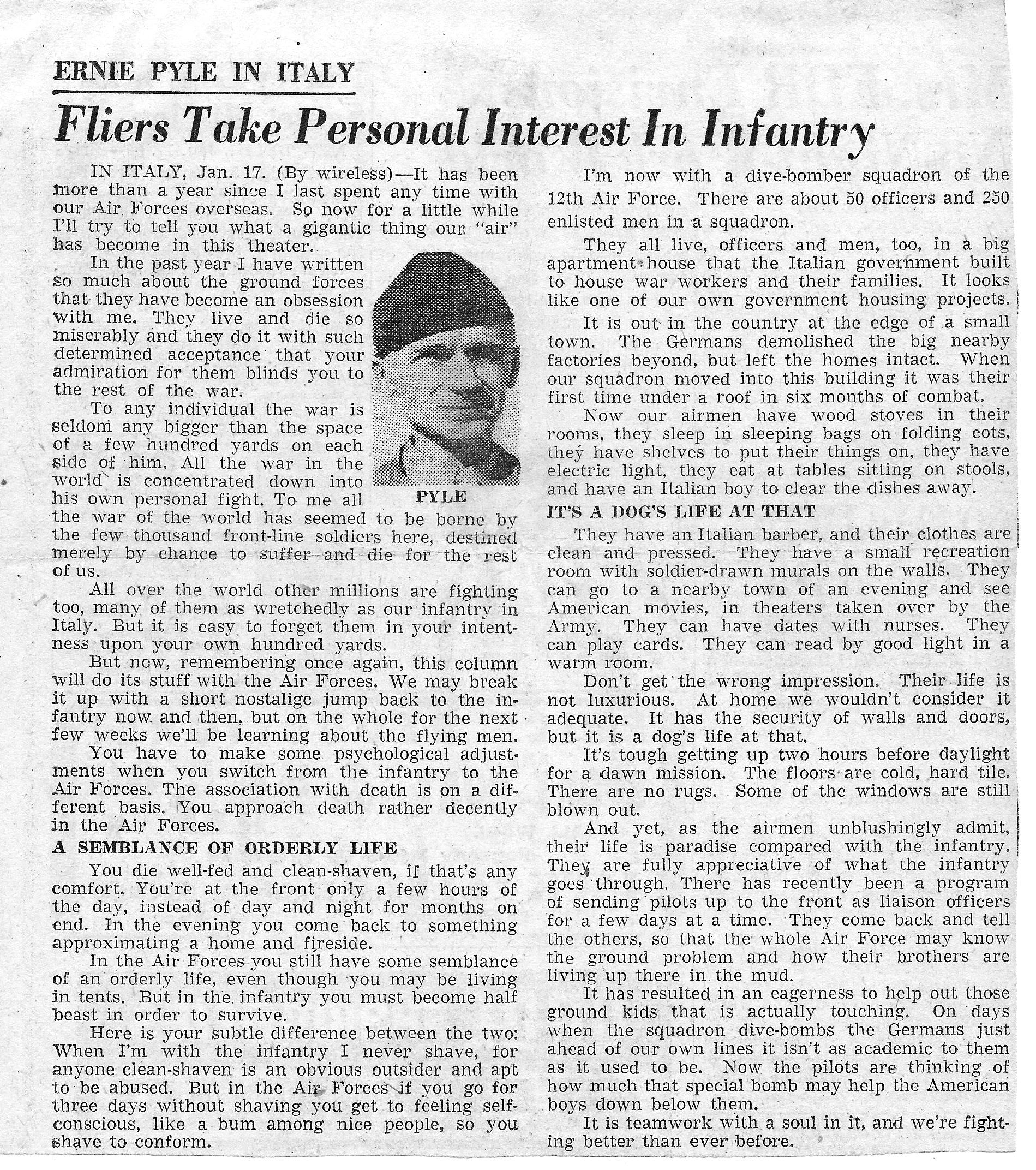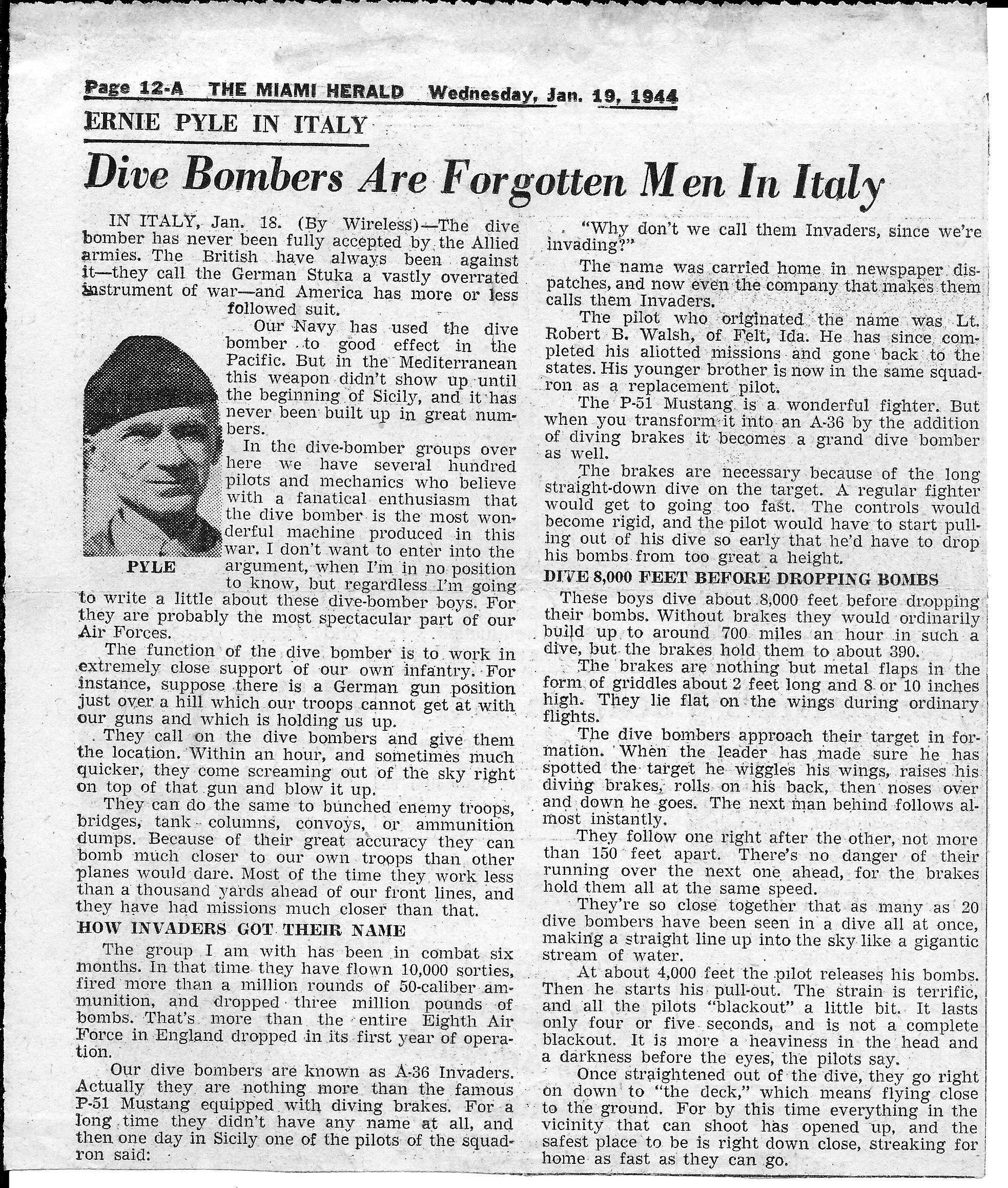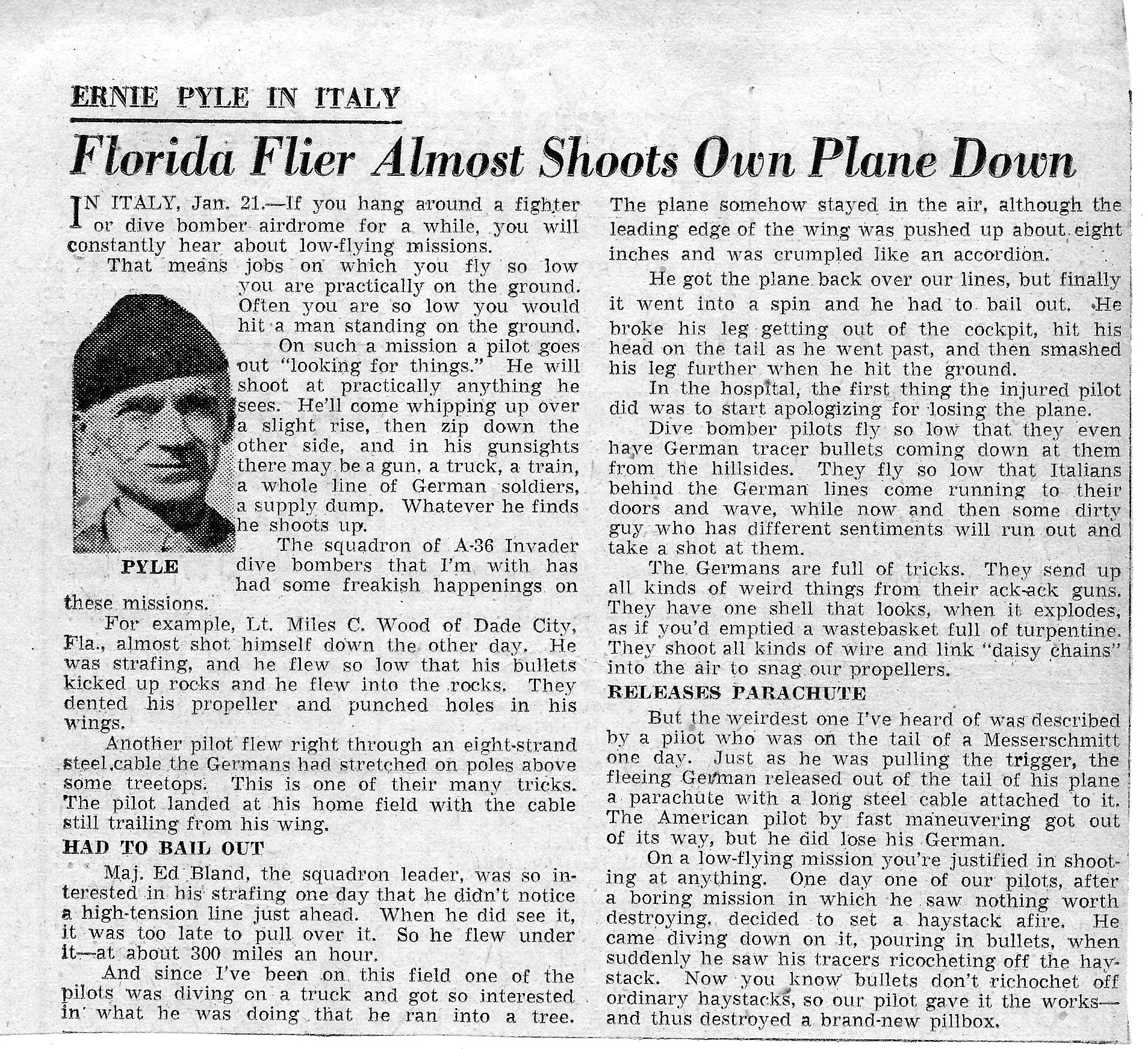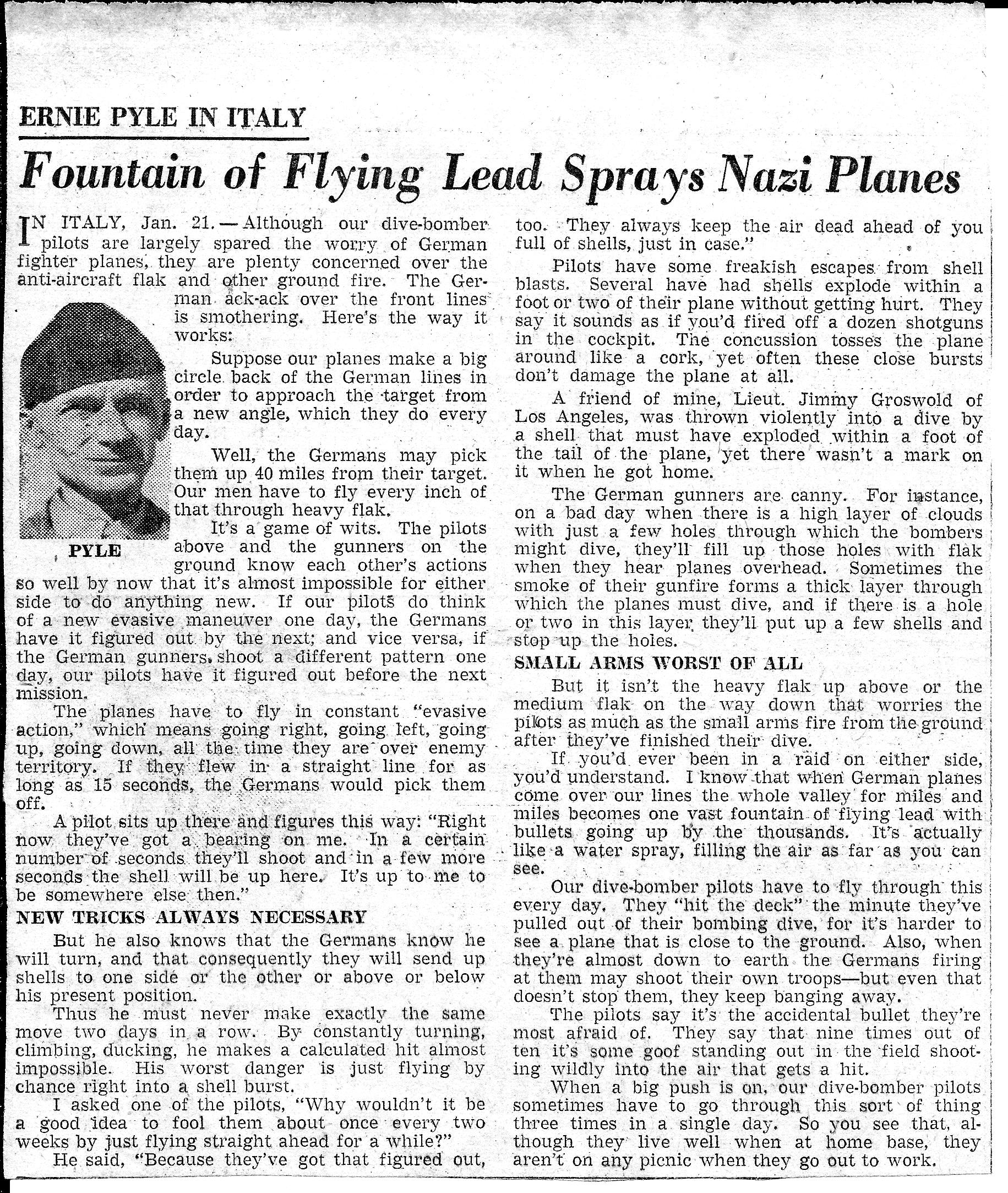1/14/44 Mission:
TACTICAL OPERATIONS (Twelfth Air Force):
In Italy, B-25's strike the Pontecorvo bridge; A-20's offer close support to US Fifth Army forces in the Monte Trocchio area; P-40's blast Loreto tank repair shops; P-40's and A-36's hit defenses in the San Giuseppe, Sant' Elia Fiumerapido. and Monte Trocchio areas; A-36's also attack road and buildings E of Minturno, the town of Isola del Liri, and the harbor at Anzio.
1/15/44 Mission:
MEDITERRANEAN ALLIED AIR FORCE (MAAF):
Lieutenant General Ira C Eaker, USAAF, assumes command of MAAF and Army Air Forces, MTO (AAFMTO), replacing Air Chief Marshall Sir Arthur Tedder, RAF, and General Carl Spaatz, who along with Air Vice Marshall Sir Arthur Coningham, RAF, and numerous other American and British officers have departed for the UK.
TACTICAL OPERATIONS (Twelfth Air Force):
In Italy, B-25's attack the Foligno railway junction; B-26's bomb bridges at Orvieto. P-40's of the 79th Fighter Group and RAF 239 Wing hit the San Valentino station in a joint attack; A-36's and other P-40's, in support of US Fifth Army forces, hit gun positions and strongpoints, especially at Picinisco and Atina; P-40's on armed reconnaissance hit the railroad W of Frosinone station and strafe the Ceccano station and railway cars.
1/16/44 Mission:
TACTICAL OPERATIONS (Twelfth Air Force):
In Italy, B-25's bomb the marshalling yard and choke points at Terni; B-26's attack the marshalling yard and bridge at Orte; A-20's bomb the town of Atina; P-40's attack bridges in the San Giorgio del Sannio area and gun emplacements near Cassino; Sant' Angelo in Theodice and Picinisco; A-36's hit the railway junction at Cecina, road and railway S of Siena, and the town areas of Avezzano and Formia.
1/17/44 Mission:
TACTICAL OPERATIONS (Twelfth Air Force):
In Italy, B-25's attack marshalling yards at Terni, Chiaravalle, and
Montemarciano; B-26's strike the Orte railway bridge and Viterbo marshalling yard; P-40's hit the Sibenik, Yugoslavia harbor, the bridge at San Giorgio del Sannio, gun positions at San Giuseppe and Formia and docks at Anzio; A-36's bomb Anzio, the Avezzano town area and road junction, and Tarquinia town and factory buildings.
1/17/44 Italy
Cara Martha Mia:
I love you! See, you didn’t have to wait for the end of the letter this time.
What a relief. One of the so-called officers in this army stole a jeep from me a couple of nights ago. Two of my men caught him today. I shall proffer charges against him tomorrow under a number of Articles of War. I hope it sticks. I can overlook almost anything but that.
Jackson is as happy as a kid on Christmas morning. He is packing for his 21 days leave. He is heading for Tunis & Cairo. Honey, I shall enjoy only leave, and that is with you. I find it very difficult to think of much else. In fact, I am definitely “Martha-sick,” not home sick.
My “moustache” (la bufa horribila) is now a thing of beauty. I think I shall get a charcoal sketch of said face & gadget, and then shave it off. I’ll mail you the sketch.
Next day—noon.
Jackson is on his way. Vance will handle ops in his absence, and I’m sure will do a good job. Gosh, I have some kids flying for me now who left home just before Christmas? It just doesn’t seem possible. Actually, Honey, I can scarcely visualize doing anything other than running a squadron, dropping bombs on Jerry, and planning and laying out new camp sites as we follow the army’s advances. Trying to get used to regular hours will be hard. We have all gotten so used to accepting as normal the fact that any inconvenience in meals or sleep is alright if it makes for more or better bombing that the thought of overtime is fantastic and inconceivable. Jackson’s new tent floor is the first thing other than bare earth since before last May! On work, it just goes on 24 hours per day. I wait until no shows are on, and leave for a few hours. There is always work when I get back.
I recently had a chance to see the entire bomb pattern from a squadron. I followed in with my squadron and saw all the bombs burst. It was most convincing. In all my flights, I had not previously seen the entire effect. Big bombs tore holes in the ground, gasoline fires flared up in orange flame and dense black smoke. The first anti-personnel bombs raised a dense, brown, dust cloud, out of which burst the piercing red flame of the remaining hundreds of anti-personnel bombs. After seeing that, their flak effort looked small, although damnably accurate. Honey, we’re winning the war in spite of all the selfish bastards back home. We are all getting sick and tired of letters from people telling us how many War Bonds they’re buying (at a wonderful interest rate).
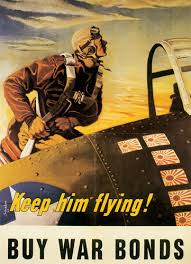
They don’t mention the taxes we’ll have to pay after we finish fighting the war for them. The ones really essential are all right, but there are a hell of a lot of them, many in the army, who have deliberately tried to keep out of combat for purely personal reasons. Honey, I wouldn’t have missed this show for anything.
Had a little fun this morning. My right brake locked, and I couldn’t very well let that stop a mission. So I got up speed, lifted said wheel off the ground, and took off on one wheel. I’ve done that before through lack of skill, but never deliberately. It works nicely.
I must stop and wash so I will look nice for Cousin Charles’ friends when I meet them this afternoon.
I love you kitten. Cy.
Back again:
I forgot to mail this so I’ll add to it.
Ernie Pyle (columnist) spent the night with me night before last. He is middle aged and wiry. I have never met a finer gentleman. Ed Bland brought him over. We found a couple of bottles of rum, and Ed, Will Gauss, Jay Stout, and of my men had a bit of a blow-out. It was most pleasant. Ernie will probably be back a little later for a longer stay.
Whee! I took off the moustache (no picture—sorry).
Had a big meeting last night. In other words a bore-ass. Much to my amazement, the OM announced I had been recommended for Lt. Col. a matter of many months ago, and all I have to wait for is administrative delay. One of these years it will come through.
Harsh will finish up one of these days.
Well, Baby, I love you even if I forget to mail letters.
Cy.
1/17/44 was also the beginning of the battle for Monte Cassino, which would last until May. The following is the timeline of the battle:
Timeline of Battle of Monte Cassino
[From: http://www.historylearningsite.co.uk/world-war-two/war-in-the-mediterranean-sea/timeline-of-battle-of-monte-cassino/]
Citation: C N Trueman “Timeline of Battle of Monte Cassino”
historylearningsite.co.uk. The History Learning Site, 19 May 2015. 16 Aug 2016.
1944
January 17th: Major Allied assault on Monte Cassino commenced.
January 24th: US 34th Division started their attack on Monte Cassino.
January 29th: It became clear that the attack on Monte Cassino had failed and the ‘first battle’ ended. Rain ensured that movement around Monte Cassino was limited with whole areas in the region flooded. Even the weight of a jeep could not be taken. Between the end of January and mid-March, the Germans took the opportunity to reorganise the defences at Monte Cassino.
March 15th: Allied bombers dropped over 1,250 tons of bombs on Cassino. 142 B-17 Flying Fortressesdropped 350 tons of bombs on the monastery on the peak of Monte Cassino. Once this bombing raid had ended, an artillery bombardment started. An attack by the New Zealand 2nd Corps was met with heavy resistance and was halted. The 4th Indian Division captured peak 165 to the northeast of Monte Cassino.
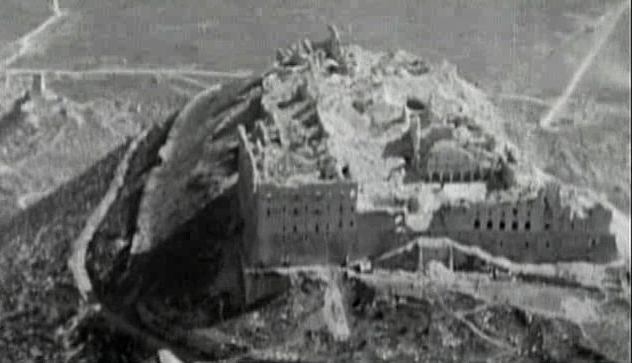
March 16th: No advances were made on the previous day’s success.
March 17th: New Zealanders took most of Cassino town. The monks at the monastery were persuaded by the Germans to leave for Rome.
March 19th: A German counter-attack failed.
March 22nd: Allied assaults were halted due to high casualty rates and lack of territorial gains.
May 11th: An all-out Allied attack on the monastery started – but not a direct assault. A new plan called on Allied forces to outflank the monastery.
May 12th: The French Expeditionary Corps launch a successful attack against German positions.
May 13th: The French opened up a direct route to Rome to the north of Monte Cassino. Other Allied forces gathered to commence a major attack on Monte Cassino.
May 14th: The British 13th Corps continued its assault on Monte Cassino.
May 17th: German forces at Monte Cassino were ordered to retreat. French forces were 25 miles to the north of Cassino.
May 18th: Troops from the Polish 12th Podolski Regiment entered the ruins of the monastery at the top of Monte Cassino.
May 25th: The US 2nd Corps linked up with the beachhead at Anzio.
Post Views:
61
